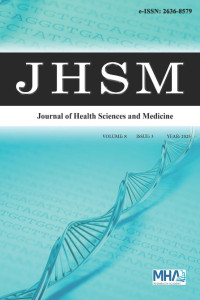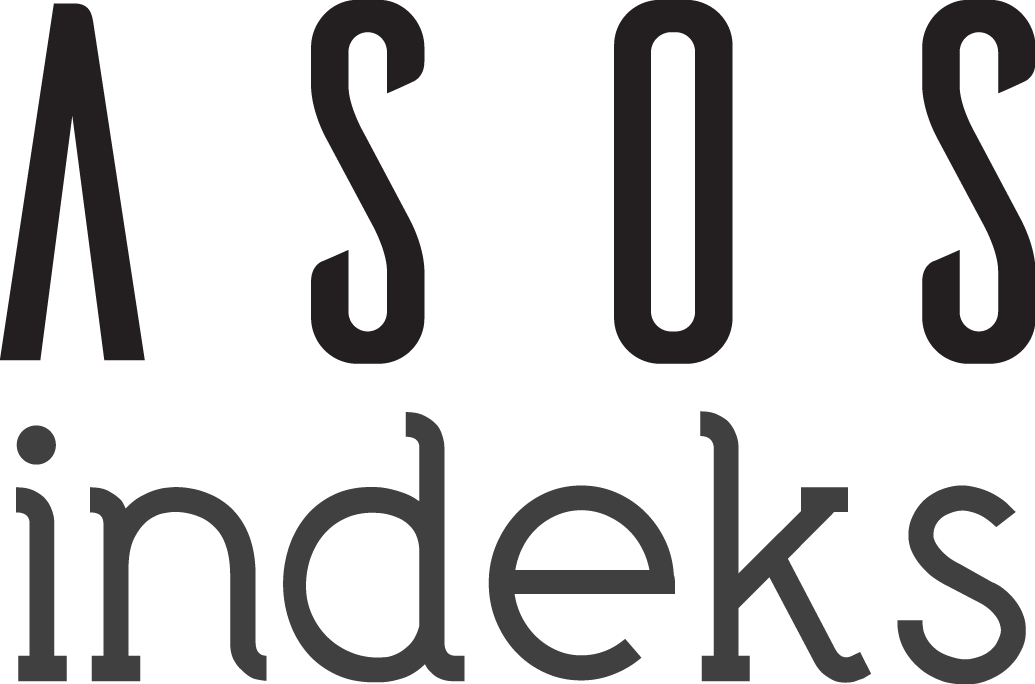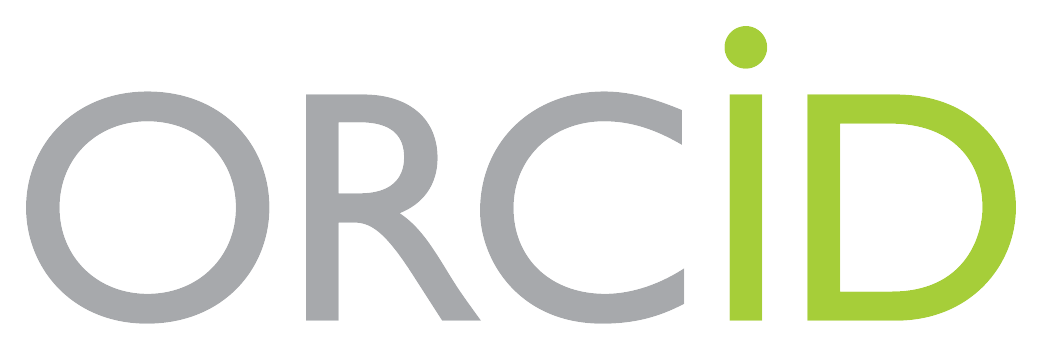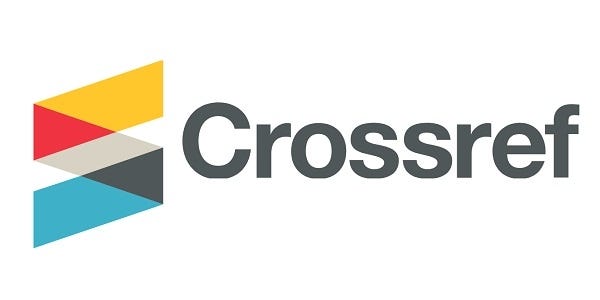Determination of obesity prejudice levels of health workers working in Gaziantep province public hospitals institution
Abstract
Aims: The aim of this study was to measure the obesity prejudice and empathic tendency of health personnel working in public hospitals in Gaziantep.
Methods: 458 healthcare professionals working in Gaziantep province participated in the study. Data were collected using “GAMS-27 Obesity Bias Scale (OBS)” and “Empathic Tendency Scale (ETS)”.
Results: It was determined that 17.5% of the healthcare professionals were unprejudiced, 53.9% were prone to prejudice and 28.6% were prejudiced. However, 9.8% of them stated that their attitudes towards obese individuals were prejudiced and 90.2% were not prejudiced. Single people were found to be more prejudiced against obesity than married people. It was found that emergency department were more prejudiced against obese individuals and had lower empathic tendencies compared to other units. Obesity prejudice scores and empathic tendency scores of those who were satisfied with their physical appearance were significantly higher than those who were not satisfied. There was a weak positive relationship between obesity prejudice score and empathic tendency score, and a weak negative relationship between age and number of children. There was a weak positive correlation between empathic tendency score and obesity prejudice score, and a weak positive correlation between age and number of children and empathic tendency score. The mean score of the Empathic Tendency Scale (ETS) of the healthcare professionals was 69.42.
Conclusion: It was determined that healthcare professionals, especially those who considered themselves as thin, young and single, were prejudiced against obesity.
Keywords
References
- Setchell J, Watson B, Jones L, Gard M, Briffa K. Physiotherapists demonstrate weight stigma: a cross-sectional survey of Australian physiotherapists. J Physiother. 2014;60(3):157-162. doi:10.1016/j.jphys. 2014.06.020
- Welborn S. Comparison of obesity bias, attitudes, and beliefs among undergraduate dietetic students, dietetic interns, and practicing registered dietitians. [Master’s thesis]. East Tennessee State University, Department of Allied Health Sciences; 2013.
- Taşan E. Identification, evaluation and epidemiology of obesity. Turk Clin Int J Med Sci. 2005;1(37):1-4.
- Mold F, Forbes A. Patients and professionals’ experiences and perspectives of obesity in health-care settings: a synthesis of current research. Health Expect. 2011;16(2):119-142. doi:10.1111/j.1369-7625.2011.00699.x
- Washington RL. Childhood obesity: issues of weight bias. [Accessed: 08.01.2025]. Available from: https://www.cdc.gov/pcd/issues/2011/sep/ 10_0281.htm.
- Diaconescu M. The concept of empathy in philosophy and psychotherapy. Studia Universitat Babes-Bolyai-Philosophia. 2008;53(1-2):105-115.
- Tutuk A, Al D, Doğan S. Determination of communication skills and empathy levels of nursing students. Cumhuriyet Univ Sch Nurs J. 2002; 6(2):36-41.
- Ay F. Determination of the effect of undergraduate education on nursing students’ empathy skill levels. Ege Univ Sch Nurs J. 2006;22(1):95-105.
- Yu J, Kirk M. Evaluation of empathy measurement tools in nursing: systematic review. J Adv Nurs. 2009;65(9):1790-1806. doi:10.1111/j.1365-2648.2009.05071.x
- Reynolds W, Scott PA, Austin W. Nursing, empathy and perception of the moral. J Adv Nurs. 2000;32(1):235-242. doi:10.1046/j.1365-2648.2000. 01440.x
- Cevahir R, Çınar N, Sözeri C, Şahin S, Kuğuoğlu S. Evaluation of the empathetic skills of midwifery students according to the classes they attend. Fırat Sağlık Hizmetleri Derg. 2008;3(2):3-15.
- Seymen S. Empathic tendencies of head nurses and nurses working at Gazimağusa State Hospital and the level of patient satisfaction with nurses. [Master’s thesis]. Nicosia: Near East University, TRNC; 2007.
- Dökmen Ü. Communication conflicts and empathy. 18th ed. Ankara: Sistem Publishing; 2004. p. 151-155.
- Ercan A, Akçil Ok M, Kızıltan G, Altun S. Development of the obesity bias scale for health sciences students. Int J Peer-Reviewed Nutr Res. 2015;2(3):29-43.
- Dökmen Ü. Measurement of empathy based on a new model and its development through psychodrama. Ankara Univ J Fac Educ Sci. 1988; 21(1):155-190. doi:10.1501/Egifak_0000000999
- Puhl R, Brownell KD. Bias, discrimination, and obesity. Obes Res. 2001; 9(12):788-805. doi:10.1038/oby.2001.108
- Schwartz MB, Chambliss HO, Brownell KD, Blair SN, Billington C. Weight bias among health professionals specializing in obesity. Obes Res. 2003;11(9):1033-1039. doi:10.1038/oby.2003.142
- Keyworth C, Peters S, Chisholm A, Hart J. Nursing students’ perceptions of obesity and behaviour change: implications for undergraduate nurse education. Nurse Educ Today. 2013;33(5):481-485. doi:10.1016/j.nedt. 2012.05.016
- Forhan M, Salas XR. Inequities in healthcare: a review of bias and discrimination in obesity treatment. Can J Diabetes. 2013;37(3):205-209. doi:10.1016/j.jcjd.2013.03.362
- Puhl RM, King KM. Weight discrimination and bullying. Best Pract Res Clin Endocrinol Metab. 2013;27(2):117-127. doi:10.1016/j.beem.2012. 12.002
- Rudd Center Food Policy and Obesity. Weight bias & stigma in healthcare. [Accessed: 05.02.2025]. Available from: http://www.uconnruddcenter.org/weight-bias-stigma-health-care.
- Gudzune KA, Beach MC, Roter DL, Cooper LA. Physicians build less rapport with obese patients. Obesity (Silver Spring). 2013;21(10):2146-2152. doi:10.1002/oby.20384
- Sert H, Seven A, Çetinkaya S, et al. Evaluation of obesity bias levels among health school students. Online Turk J Health Sci. 2016;1(4):9-17.
- Öztürk Altınkaynak S, Gür EY, Ejder Apay S, et al. Midwifery students’ bias towards obese pregnant women. Anat J Nurs Health Sci. 2017;20:3.
- Okumuşoğlu S. The relationship between teasing about body weight and physical activity level and attitudes towards diet in obese adolescents. Int J Humanit Sci Educ. 2012;3(2):195-208.
- Ünal D. Evaluation of healthcare workers’ attitudes towards obese individuals. [Master’s thesis]. Institute of Health Sciences; 2018.
- Koyu EB, Karaağa, Y, Miçooğulları Ş. Obesity prejudice and related factors among health sciences students. Turk J Diabet Obesity. 2020;4(3): 260-269. doi:10.25048/tudod.790209
- Yavuz AY, Baysal H. Prejudice obesity of midwives and nurses in the primary health care. Adnan Menderes Üni Sağ Bil Fak Derg. 2020;4(3): 195-202. doi:10.46237/amusbfd.674895
- Koç M. The relationship between demographic characteristics and empathic tendencies: an empirical study on adults. Iğdır Univ J Soc Sci. 2016;9:25-47.
- Özcan H. Empathic tendencies and empathic skills of nurses: the Gümüşhane example. Gümüşhane Univ J Health Sci. 2012;1(2):60-68.
- Akgöz S, Karavuş M. Evaluation of empathic communication skills of nurses working in health centers and health houses in Çanakkale province. Turk Clin J Med Ethics. 2005;13:14-19.
- Dizer B, İyigün E. Empathic tendency levels and influencing factors in intensive care unit nurses. Atatürk Univ J Nurs High Sch. 2009;12(1):9-19.
- Yiğitbaş Ç, Deveci SE, Açık Y, et al. Empathic tendencies and skills of a group of students receiving health education. Süleyman Demirel Univ J Health Sci. 2013;4(1):7-13.
Gaziantep ili kamu hastaneleri kurumuna bağlı görev yapan sağlık çalışanlarının obezite önyargı düzeylerinin saptanması
Abstract
Amaç: Bu çalışmada Gaziantep İli Kamu hastanelerinde çalışan sağlık personellerinin obezite önyargısını ve empatik eğilimini ölçmek amaçlanmıştır.
Gereç-Yöntem: Çalışmaya Gaziantep ilinde çalışan 458 sağlık personeli katılmıştır. “GAMS-27 Obezite Önyargı Ölçeği (OÖÖ)” ve “Empatik Eğilim Ölçeği (EEÖ)” kullanılarak veriler toplanmıştır.
Bulgular: Sağlık çalışanlarının %17,5’i ön yargısız, %53,9’u ön yargı eğilimli ve %28’6’sı ön yargılı olduğu belirlenmiştir. Ancak obez bireylere karşı tutumlarının %9,8’i ön yargılı olduğunu, %90,2’si ön yargısız olduğunu belirtmektedir. Bekar kişilerin evli olanlara göre obeziteye daha önyargılı olduğu saptanmıştır. Acilde çalışanların diğer birimlere göre obez bireylere karşı daha önyargılı ve empatik eğilimlerinin daha düşük olduğu bulunmuştur. Fiziksel görünümünden memnun olanların obezite ön yargı puanları ve empatik eğilim puanları memnun olmayanlardan anlamlı yüksek bulunmuştur. Obezite ön yargı puanı ile empatik eğilim puanı arasında pozitif yönde zayıf bir ilişki, yaş ile çocuk sayısı arasında negatif yönde zayıf bir ilişki bulunmaktadır. Empatik eğilim puanı ile obezite ön yargı puanı arasında pozitif yönde zayıf bir ilişki, yaş ve çocuk sayısı arasında empatik eğilim puanı arasında pozitif yönde zayıf bir ilişki bulunmaktadır.
Sonuç: Sağlık çalışanlarının; özellikle kendini zayıf olarak gören, genç ve bekar kişilerin obeziteye karşı önyargılı olduğu belirlenmiştir. Sağlık çalışanlarının Empatik Eğilim Ölçeği (EEÖ) puan ortalaması 69.42 olarak tespit edilmiştir.
Keywords
References
- Setchell J, Watson B, Jones L, Gard M, Briffa K. Physiotherapists demonstrate weight stigma: a cross-sectional survey of Australian physiotherapists. J Physiother. 2014;60(3):157-162. doi:10.1016/j.jphys. 2014.06.020
- Welborn S. Comparison of obesity bias, attitudes, and beliefs among undergraduate dietetic students, dietetic interns, and practicing registered dietitians. [Master’s thesis]. East Tennessee State University, Department of Allied Health Sciences; 2013.
- Taşan E. Identification, evaluation and epidemiology of obesity. Turk Clin Int J Med Sci. 2005;1(37):1-4.
- Mold F, Forbes A. Patients and professionals’ experiences and perspectives of obesity in health-care settings: a synthesis of current research. Health Expect. 2011;16(2):119-142. doi:10.1111/j.1369-7625.2011.00699.x
- Washington RL. Childhood obesity: issues of weight bias. [Accessed: 08.01.2025]. Available from: https://www.cdc.gov/pcd/issues/2011/sep/ 10_0281.htm.
- Diaconescu M. The concept of empathy in philosophy and psychotherapy. Studia Universitat Babes-Bolyai-Philosophia. 2008;53(1-2):105-115.
- Tutuk A, Al D, Doğan S. Determination of communication skills and empathy levels of nursing students. Cumhuriyet Univ Sch Nurs J. 2002; 6(2):36-41.
- Ay F. Determination of the effect of undergraduate education on nursing students’ empathy skill levels. Ege Univ Sch Nurs J. 2006;22(1):95-105.
- Yu J, Kirk M. Evaluation of empathy measurement tools in nursing: systematic review. J Adv Nurs. 2009;65(9):1790-1806. doi:10.1111/j.1365-2648.2009.05071.x
- Reynolds W, Scott PA, Austin W. Nursing, empathy and perception of the moral. J Adv Nurs. 2000;32(1):235-242. doi:10.1046/j.1365-2648.2000. 01440.x
- Cevahir R, Çınar N, Sözeri C, Şahin S, Kuğuoğlu S. Evaluation of the empathetic skills of midwifery students according to the classes they attend. Fırat Sağlık Hizmetleri Derg. 2008;3(2):3-15.
- Seymen S. Empathic tendencies of head nurses and nurses working at Gazimağusa State Hospital and the level of patient satisfaction with nurses. [Master’s thesis]. Nicosia: Near East University, TRNC; 2007.
- Dökmen Ü. Communication conflicts and empathy. 18th ed. Ankara: Sistem Publishing; 2004. p. 151-155.
- Ercan A, Akçil Ok M, Kızıltan G, Altun S. Development of the obesity bias scale for health sciences students. Int J Peer-Reviewed Nutr Res. 2015;2(3):29-43.
- Dökmen Ü. Measurement of empathy based on a new model and its development through psychodrama. Ankara Univ J Fac Educ Sci. 1988; 21(1):155-190. doi:10.1501/Egifak_0000000999
- Puhl R, Brownell KD. Bias, discrimination, and obesity. Obes Res. 2001; 9(12):788-805. doi:10.1038/oby.2001.108
- Schwartz MB, Chambliss HO, Brownell KD, Blair SN, Billington C. Weight bias among health professionals specializing in obesity. Obes Res. 2003;11(9):1033-1039. doi:10.1038/oby.2003.142
- Keyworth C, Peters S, Chisholm A, Hart J. Nursing students’ perceptions of obesity and behaviour change: implications for undergraduate nurse education. Nurse Educ Today. 2013;33(5):481-485. doi:10.1016/j.nedt. 2012.05.016
- Forhan M, Salas XR. Inequities in healthcare: a review of bias and discrimination in obesity treatment. Can J Diabetes. 2013;37(3):205-209. doi:10.1016/j.jcjd.2013.03.362
- Puhl RM, King KM. Weight discrimination and bullying. Best Pract Res Clin Endocrinol Metab. 2013;27(2):117-127. doi:10.1016/j.beem.2012. 12.002
- Rudd Center Food Policy and Obesity. Weight bias & stigma in healthcare. [Accessed: 05.02.2025]. Available from: http://www.uconnruddcenter.org/weight-bias-stigma-health-care.
- Gudzune KA, Beach MC, Roter DL, Cooper LA. Physicians build less rapport with obese patients. Obesity (Silver Spring). 2013;21(10):2146-2152. doi:10.1002/oby.20384
- Sert H, Seven A, Çetinkaya S, et al. Evaluation of obesity bias levels among health school students. Online Turk J Health Sci. 2016;1(4):9-17.
- Öztürk Altınkaynak S, Gür EY, Ejder Apay S, et al. Midwifery students’ bias towards obese pregnant women. Anat J Nurs Health Sci. 2017;20:3.
- Okumuşoğlu S. The relationship between teasing about body weight and physical activity level and attitudes towards diet in obese adolescents. Int J Humanit Sci Educ. 2012;3(2):195-208.
- Ünal D. Evaluation of healthcare workers’ attitudes towards obese individuals. [Master’s thesis]. Institute of Health Sciences; 2018.
- Koyu EB, Karaağa, Y, Miçooğulları Ş. Obesity prejudice and related factors among health sciences students. Turk J Diabet Obesity. 2020;4(3): 260-269. doi:10.25048/tudod.790209
- Yavuz AY, Baysal H. Prejudice obesity of midwives and nurses in the primary health care. Adnan Menderes Üni Sağ Bil Fak Derg. 2020;4(3): 195-202. doi:10.46237/amusbfd.674895
- Koç M. The relationship between demographic characteristics and empathic tendencies: an empirical study on adults. Iğdır Univ J Soc Sci. 2016;9:25-47.
- Özcan H. Empathic tendencies and empathic skills of nurses: the Gümüşhane example. Gümüşhane Univ J Health Sci. 2012;1(2):60-68.
- Akgöz S, Karavuş M. Evaluation of empathic communication skills of nurses working in health centers and health houses in Çanakkale province. Turk Clin J Med Ethics. 2005;13:14-19.
- Dizer B, İyigün E. Empathic tendency levels and influencing factors in intensive care unit nurses. Atatürk Univ J Nurs High Sch. 2009;12(1):9-19.
- Yiğitbaş Ç, Deveci SE, Açık Y, et al. Empathic tendencies and skills of a group of students receiving health education. Süleyman Demirel Univ J Health Sci. 2013;4(1):7-13.
Details
| Primary Language | English |
|---|---|
| Subjects | Health Promotion |
| Journal Section | Original Article |
| Authors | |
| Publication Date | May 30, 2025 |
| Submission Date | March 1, 2025 |
| Acceptance Date | May 9, 2025 |
| Published in Issue | Year 2025 Volume: 8 Issue: 3 |
Interuniversity Board (UAK) Equivalency: Article published in Ulakbim TR Index journal [10 POINTS], and Article published in other (excuding 1a, b, c) international indexed journal (1d) [5 POINTS].
The Directories (indexes) and Platforms we are included in are at the bottom of the page.
Note: Our journal is not WOS indexed and therefore is not classified as Q.
You can download Council of Higher Education (CoHG) [Yüksek Öğretim Kurumu (YÖK)] Criteria) decisions about predatory/questionable journals and the author's clarification text and journal charge policy from your browser. https://dergipark.org.tr/tr/journal/2316/file/4905/show
The indexes of the journal are ULAKBİM TR Dizin, Index Copernicus, ICI World of Journals, DOAJ, Directory of Research Journals Indexing (DRJI), General Impact Factor, ASOS Index, WorldCat (OCLC), MIAR, EuroPub, OpenAIRE, Türkiye Citation Index, Türk Medline Index, InfoBase Index, Scilit, etc.
The platforms of the journal are Google Scholar, CrossRef (DOI), ResearchBib, Open Access, COPE, ICMJE, NCBI, ORCID, Creative Commons, etc.
| ||
|
Our Journal using the DergiPark system indexed are;
Ulakbim TR Dizin, Index Copernicus, ICI World of Journals, Directory of Research Journals Indexing (DRJI), General Impact Factor, ASOS Index, OpenAIRE, MIAR, EuroPub, WorldCat (OCLC), DOAJ, Türkiye Citation Index, Türk Medline Index, InfoBase Index
Our Journal using the DergiPark system platforms are;
Journal articles are evaluated as "Double-Blind Peer Review".
Our journal has adopted the Open Access Policy and articles in JHSM are Open Access and fully comply with Open Access instructions. All articles in the system can be accessed and read without a journal user. https//dergipark.org.tr/tr/pub/jhsm/page/9535
Journal charge policy https://dergipark.org.tr/tr/pub/jhsm/page/10912
Our journal has been indexed in DOAJ as of May 18, 2020.
Our journal has been indexed in TR-Dizin as of March 12, 2021.
Articles published in the Journal of Health Sciences and Medicine have open access and are licensed under the Creative Commons CC BY-NC-ND 4.0 International License.















